Unit 4 Body language Reading and Thinking 课件(共24张,内嵌视频)-人教版(2019)选择性必修第一册
文档属性
| 名称 | Unit 4 Body language Reading and Thinking 课件(共24张,内嵌视频)-人教版(2019)选择性必修第一册 | 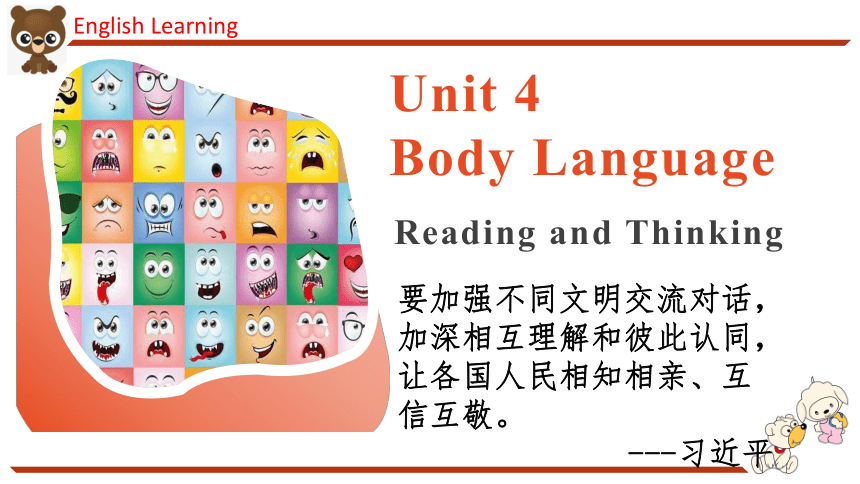 | |
| 格式 | pptx | ||
| 文件大小 | 31.3MB | ||
| 资源类型 | 教案 | ||
| 版本资源 | 人教版(2019) | ||
| 科目 | 英语 | ||
| 更新时间 | 2025-07-29 17:17:11 | ||
图片预览

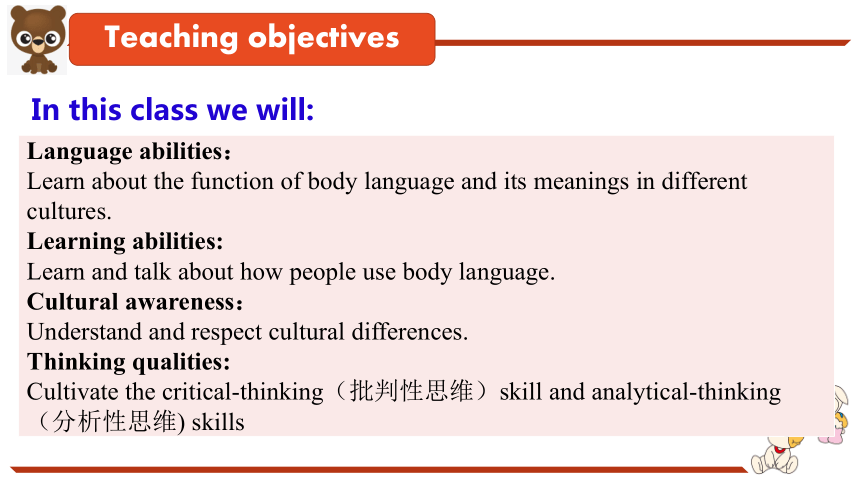

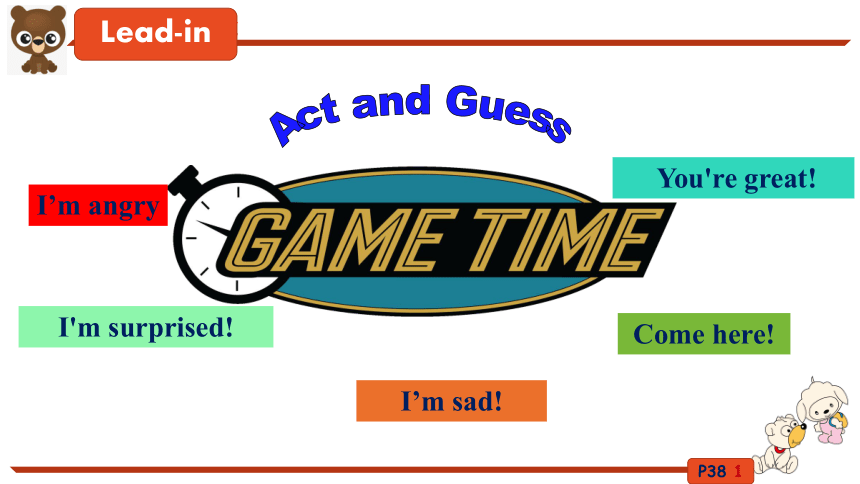
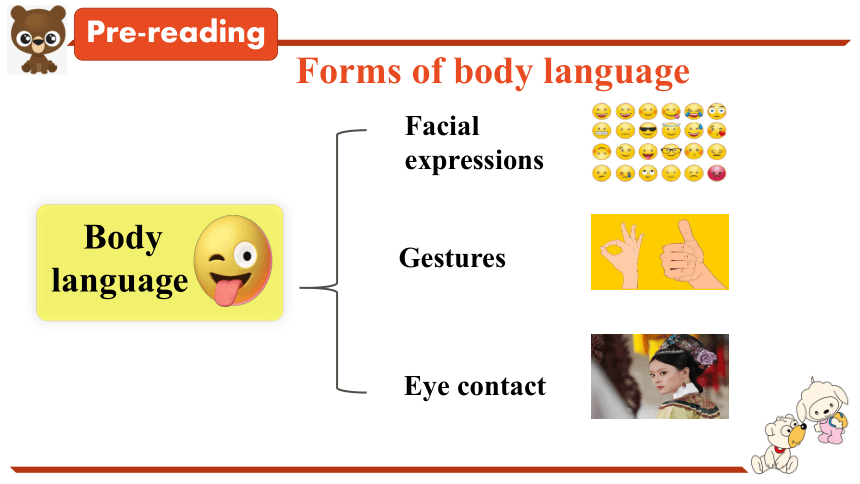
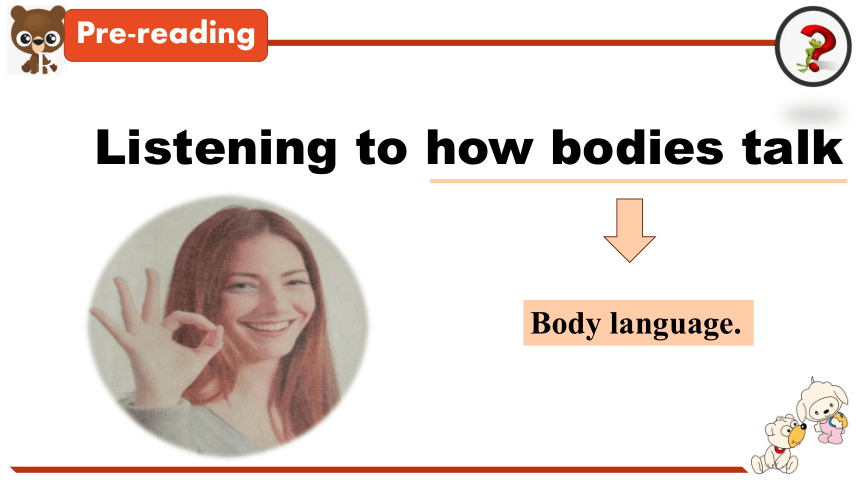
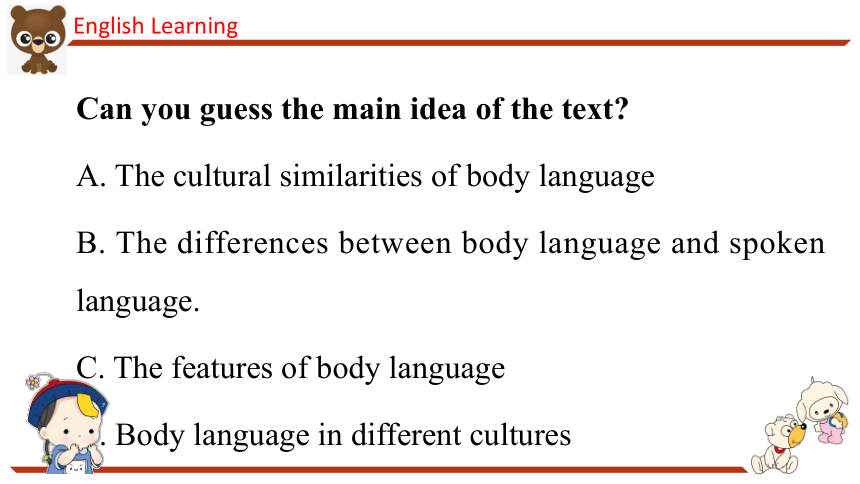
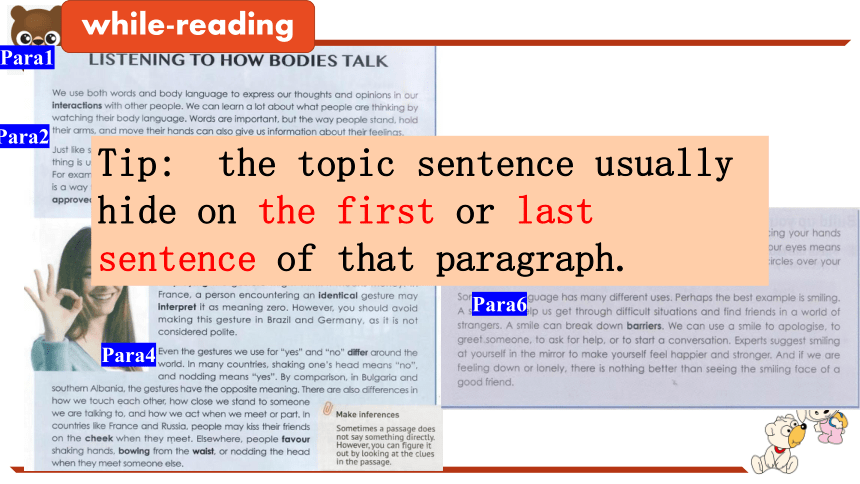
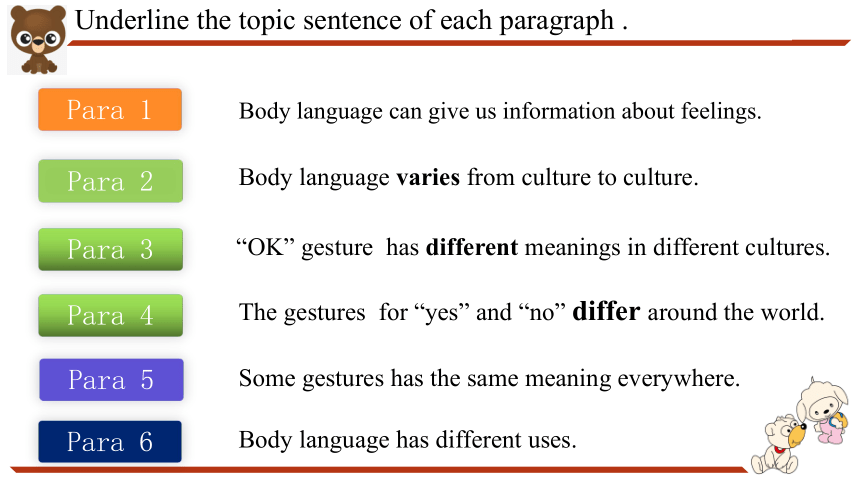
文档简介
(共24张PPT)
Unit 4
Body Language
Reading and Thinking
要加强不同文明交流对话,加深相互理解和彼此认同,让各国人民相知相亲、互信互敬。
---习近平
In this class we will:
Language abilities:
Learn about the function of body language and its meanings in different cultures.
Learning abilities:
Learn and talk about how people use body language.
Cultural awareness:
Understand and respect cultural differences.
Thinking qualities:
Cultivate the critical-thinking(批判性思维)skill and analytical-thinking
(分析性思维) skills
Teaching objectives
文明没有高下、优劣之分,只有特色、地域之别。文明差异不应该成为世界冲突的根源,而应该成为人类文明进步的动力。
---习近平
Come here!
I’m sad!
I'm surprised!
You're great!
P38 1
Act and Guess
I’m angry
Lead-in
Gestures
Eye contact
Facial
expressions
Body language
Forms of body language
Pre-reading
Listening to how bodies talk
Reading and thinking
Body language.
Pre-reading
Can you guess the main idea of the text
A. The cultural similarities of body language
B. The differences between body language and spoken language.
C. The features of body language
D. Body language in different cultures
Para1
Para2
Para3
Para4
Para5
Para6
Tip: the topic sentence usually hide on the first or last sentence of that paragraph.
while-reading
Underline the topic sentence of each paragraph .
Para 1
Para 5
Para 6
Body language can give us information about feelings.
Some gestures has the same meaning everywhere.
Body language has different uses.
Body language varies from culture to culture.
“OK” gesture has different meanings in different cultures.
The gestures for “yes” and “no” differ around the world.
Para 2
Para 3
Para 4
A
B
C
①②
③④ ⑤⑥
①
②③④ ⑤ ⑥
①
②③④⑤ ⑥
The differences
The similarities
Different uses
The introduction
Task 2. Read for the structure
Body language/
Gesture
Country/Region
Meaning
Eye contact
Some countries
Interest
Middle Eastern
countries
Not polite
Look down when talking to someone
Japan
Respect
Task 3 Detailed reading P2-5
Money
Japan
Zero
France
Not polite
Brazil/Germany
Kiss on the cheek
Meaning
Country/region
sleep
everywhere
I’m full
Body language/Gesture
Placing your hands together and resting them on the side of your head while closing your eyes.
Moving your hand in circles over your stomach after a meal.
greet
France and Russia
Read para 6 and answer the following questions.
1.Which one is not the use of smiling
A. To cheer you up
B. To help you get through difficult situations
C. To start a conversation
D. To help those in need
2. Which statement does the author agree with
A. Never too old to learn
B. Four eyes see more than two.
C.A smile is the best business card.
D. Every country has its own customs.
Shake the head
Ok
Shake hands
Eye
contact
Nod the head
post-reading
Body language
in China
Interested/ polite
Yes
No
Greet
agreement
Role Play
If you are a Chinese student, you should greet international exchange students from Japan, France and the Middle East at the airport……
post-reading
small talk
(Don’t forget to use body language)
summary
2.In some situations, body language is the better way to say.
What I hide by my language, my body utters.
1.Different body languages have different meanings in different countries.
When in Rome, do as the Romans do.
Solve all kinds of problems
Avoid misunderstanding
Break down the language barriers.
Write an advice letter to Nick on
body language interaction
on his first trip to China.
Homework
After learning the lesson, I can… Scores Improvement
Learn about the function of body language and its meanings in different cultures. 1 2 3 4 5
Improve your reading skills 1 2 3 4 5
understand the meanings of body language in China 1 2 3 4 5
learn to respect cultural differences 1 2 3 4 5
Self-assessment
Thank you !
We use both words and body language __________(express) our thoughts and opinions in our ____________(interact) with other people. Just like spoken language, body language _________(vary) from culture to culture. The crucial thing is _________(use) body language in a way that is appropriate to the culture you are in. For example, _______ (make) eye contact is not appropriate to all cultures. Some gestures like the one for “OK’ have different meanings in different cultures. Even the gestures we use for “yes”and “no”differ around the world. There are also differences ______ how we touch each other, how close we stand _____ someone we are talking to, and how we act when we meet or part. Such gestures as the ones for “sleep”and “I am full” seem to have _____ same meaning everywhere.Some body language has many different uses. One example is smiling.
to express
interactions
varies
using
making
in
to
the
Fill in the blanks according to the text.
Unit 4
Body Language
Reading and Thinking
要加强不同文明交流对话,加深相互理解和彼此认同,让各国人民相知相亲、互信互敬。
---习近平
In this class we will:
Language abilities:
Learn about the function of body language and its meanings in different cultures.
Learning abilities:
Learn and talk about how people use body language.
Cultural awareness:
Understand and respect cultural differences.
Thinking qualities:
Cultivate the critical-thinking(批判性思维)skill and analytical-thinking
(分析性思维) skills
Teaching objectives
文明没有高下、优劣之分,只有特色、地域之别。文明差异不应该成为世界冲突的根源,而应该成为人类文明进步的动力。
---习近平
Come here!
I’m sad!
I'm surprised!
You're great!
P38 1
Act and Guess
I’m angry
Lead-in
Gestures
Eye contact
Facial
expressions
Body language
Forms of body language
Pre-reading
Listening to how bodies talk
Reading and thinking
Body language.
Pre-reading
Can you guess the main idea of the text
A. The cultural similarities of body language
B. The differences between body language and spoken language.
C. The features of body language
D. Body language in different cultures
Para1
Para2
Para3
Para4
Para5
Para6
Tip: the topic sentence usually hide on the first or last sentence of that paragraph.
while-reading
Underline the topic sentence of each paragraph .
Para 1
Para 5
Para 6
Body language can give us information about feelings.
Some gestures has the same meaning everywhere.
Body language has different uses.
Body language varies from culture to culture.
“OK” gesture has different meanings in different cultures.
The gestures for “yes” and “no” differ around the world.
Para 2
Para 3
Para 4
A
B
C
①②
③④ ⑤⑥
①
②③④ ⑤ ⑥
①
②③④⑤ ⑥
The differences
The similarities
Different uses
The introduction
Task 2. Read for the structure
Body language/
Gesture
Country/Region
Meaning
Eye contact
Some countries
Interest
Middle Eastern
countries
Not polite
Look down when talking to someone
Japan
Respect
Task 3 Detailed reading P2-5
Money
Japan
Zero
France
Not polite
Brazil/Germany
Kiss on the cheek
Meaning
Country/region
sleep
everywhere
I’m full
Body language/Gesture
Placing your hands together and resting them on the side of your head while closing your eyes.
Moving your hand in circles over your stomach after a meal.
greet
France and Russia
Read para 6 and answer the following questions.
1.Which one is not the use of smiling
A. To cheer you up
B. To help you get through difficult situations
C. To start a conversation
D. To help those in need
2. Which statement does the author agree with
A. Never too old to learn
B. Four eyes see more than two.
C.A smile is the best business card.
D. Every country has its own customs.
Shake the head
Ok
Shake hands
Eye
contact
Nod the head
post-reading
Body language
in China
Interested/ polite
Yes
No
Greet
agreement
Role Play
If you are a Chinese student, you should greet international exchange students from Japan, France and the Middle East at the airport……
post-reading
small talk
(Don’t forget to use body language)
summary
2.In some situations, body language is the better way to say.
What I hide by my language, my body utters.
1.Different body languages have different meanings in different countries.
When in Rome, do as the Romans do.
Solve all kinds of problems
Avoid misunderstanding
Break down the language barriers.
Write an advice letter to Nick on
body language interaction
on his first trip to China.
Homework
After learning the lesson, I can… Scores Improvement
Learn about the function of body language and its meanings in different cultures. 1 2 3 4 5
Improve your reading skills 1 2 3 4 5
understand the meanings of body language in China 1 2 3 4 5
learn to respect cultural differences 1 2 3 4 5
Self-assessment
Thank you !
We use both words and body language __________(express) our thoughts and opinions in our ____________(interact) with other people. Just like spoken language, body language _________(vary) from culture to culture. The crucial thing is _________(use) body language in a way that is appropriate to the culture you are in. For example, _______ (make) eye contact is not appropriate to all cultures. Some gestures like the one for “OK’ have different meanings in different cultures. Even the gestures we use for “yes”and “no”differ around the world. There are also differences ______ how we touch each other, how close we stand _____ someone we are talking to, and how we act when we meet or part. Such gestures as the ones for “sleep”and “I am full” seem to have _____ same meaning everywhere.Some body language has many different uses. One example is smiling.
to express
interactions
varies
using
making
in
to
the
Fill in the blanks according to the text.
